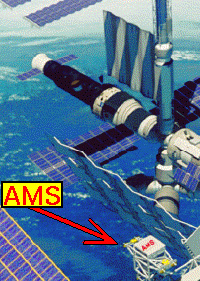

The cargo bay of the Space Shuttle Discovery before its launch for the STS-91 mission.
A view of AMS mounted on the International Space Station
AMS (continued)
A first simpler version of the experiment, AMS-01, traveled on the Space Shuttle Discovery for a ten-day mission in 1998. The apparatus consisted of a 6-layer 'silicon microstrip track detector' surrounded by a permanent magnet and a few other systems.
Silicon microstrips can localize the passage of charged particles with a precision of a few hundredth of a millimeter (less than a human hair). The magnet produced a magnetic field where incoming particles were deflected in opposite directions. Nuclei are thus identified by measuring both their mass and charge.
During the 10 days that AMS was in space, not a single antinucleus was seen among the 3 million nuclei that traversed the experiment.
In 2004, a new version of the experiment, called AMS-02, will be installed on the International Space Station. AMS-02 will again be searching for any extragalactic antimatter, but this time with more sensitivity, over a longer time period and in a wider energy range.
The new apparatus will be equipped with a superconducting magnet, providing a much higher magnetic field, and an enhanced silicon tracker, able to record billions of tracks of matter (and antimatter?) particles. Other detectors have also been added to the design to better identify and measure incoming particles and nuclei. AMS-02 will be installed on the long arm of the ISS and exposed to cosmic rays for three years.
This very moment, a few modules of ISS are already orbiting over our heads. With the experimental data collected during this second mission, AMS hopes to find the last traces of big-bang antimatter, if there are any left!
|
(Antimatter
in Cosmology - page 3 of 3)
< Prev | |


